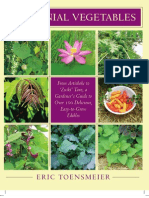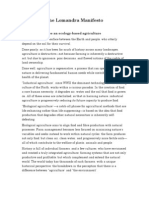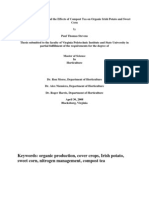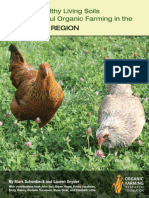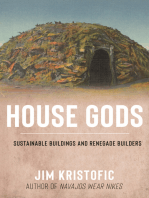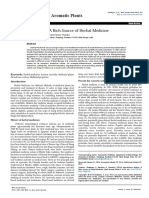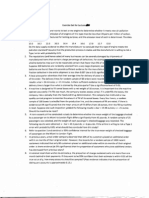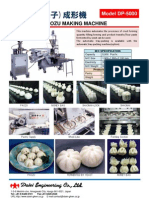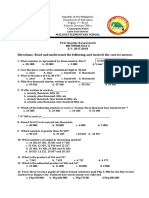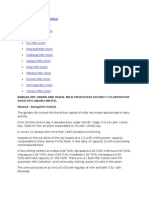The Soul of Soil: by John Jeavons Illustrations by Judy Chance Hope
The Soul of Soil: by John Jeavons Illustrations by Judy Chance Hope
Uploaded by
johnnyorithroCopyright:
Available Formats
The Soul of Soil: by John Jeavons Illustrations by Judy Chance Hope
The Soul of Soil: by John Jeavons Illustrations by Judy Chance Hope
Uploaded by
johnnyorithroOriginal Title
Copyright
Available Formats
Share this document
Did you find this document useful?
Is this content inappropriate?
Copyright:
Available Formats
The Soul of Soil: by John Jeavons Illustrations by Judy Chance Hope
The Soul of Soil: by John Jeavons Illustrations by Judy Chance Hope
Uploaded by
johnnyorithroCopyright:
Available Formats
THE SOUL OF SOIL
by John Jeavons
Illustrations by Judy Chance Hope
Soul of Soil by John Jeavons
The Soul of Soil © 2016 John Jeavons. All Rights Reserved.
Soul of Soil by John Jeavons
The Soul of Soil
I am just beginning! Awed by the soil—its life, wonderful smell,
crumbly texture! The vitality that grows in and from it! Life-giving
weeds that build up root organic matter and minerals from deep in the
soil—concentrating nutrients in themselves with food and medicinal
properties to nurture us all. What a privilege it is to nurture it.
When minerals are depleted, nettles move in—build up the soil—
then move on 40 years later, after they have replenished the soils’ essence.
Bushes, trees, vegetables, fruit, grains and beans thrive.
Why?
Microbes. Billions of life forms in a tablespoon full of compost—
almost as many in one, as there are people on the Earth! May the Force
be with us! Biologically intensive cultivation/civilization really is a
dynamic thriving living Dance. Let’s participate!
North Africa was the granary for Rome—until it was overfarmed.
The Sahara Desert a forest until it was overcut. Who really thinks healthy
life can be be grown with poisons? Gandhi, in response to being asked,
“What do you think about Western civilization? replied, “It would be a
good idea!”
Food-growing is too much work, you say?
10,000 years ago in northern Iran, the people in its Early Stone Age
culture grew virtually all their calories with the original spelt wheat in
an average of 3.7 minutes a day. The Philippine Hananoo “stone-age”
culture is considered illiterate by our civilization—yet they grow all their
food in a 5-year rotation comprised of 200 crops—including 40 different
varieties of rice, so that no matter what the weather, too hot or cold or
wet or dry, they grow sufficient calories. Looked at from this perspective,
the Hananoo are simply a different kind of literate: Farming Literate!
Soul of Soil by John Jeavons
Until the 1950’s, the Chinese considered their farmers to be “Living
Libraries”. Truly skilled farmers, with real connection to the land, know
more than 4 millennia of experience—school experience—the growing
experience in their current lives. They know in their hands, hearts and
senses. This is knowledge that is available to all of us if we seek it. We can
become Living Libraries too.
The Mayan culture, 1,000 years ago, thrived, when civilizations
around it disappeared. Their civilization was based on biologically
intensive neighborhood food-growing—the original food localization
movement!
Soon most people will only have 4,500 square feet per person
on which to grow their sustenance. Alan Chadwick, my mentor, said
the most important thing to consider is the direction in which we are
going—not where we are. Right now, the direction we’re going is not one
most of us want to take:
• 50% of Africa is already on starvation track. Since 2013, 50% of
the people living in Mexico are spending 70% of their disposable income
on food—only getting 1/3 of their calories each day.
• The UN-FAO indicates that in 10 years two-thirds of the world
population, ~5.5 billion people, may well not have the necessary water to
grow a sufficient diet, and many of them will have no food at all.
2
Soul of Soil by John Jeavons
We can change direction!
Biologically intensive food-growing can grow sufficient food for a
complete diet annually, on as little as 1,000 square feet, with 33% of the
water, while—if used properly—growing soil up to 60 times faster than
in Nature—in as little as 50 years. During this build up time, food and
compost materials can be produced as well.
We need to GROW SOIL now. It is the basis upon which we all
depend. Test your soil! Adding an initial burst of 20% of your soil’s
needed/missing key soil nutrients may produce an 80% increase in
crop yield. For example, sufficient calcium in the soil means that other
major and trace minerals may be picked up more easily by the plants you
grow. Making the most of your resources means working smarter, not
harder. In another example, in a biologically intensive living soil system,
up to 100% of all added nutrients may be utilized—in comparison with
conventional practices—which generally use only 15% of the added
nitrogen. Composting grows soil and recycles many of the nutrients so
you don’t have to keep adding them!
3
Soul of Soil by John Jeavons
Why work harder, use more resources, more of the Earth when
you can think smarter? Biologically intensive soil growing can be skill
intensive—and does not need to be work intensive.
Goals—Grow oneself. Grow intuition. Grow experience.
Community—An important form of Sustainability. Grow Life!
For example, compared with 10,000 years ago, there are only
11% of the trees left on the Earth in biomass terms. When only 67% were
left, this “skin of the Earth” began to die. Yet, if each person in the world
plants, or causes to be planted, just 20 trees a year for 5 years for a total
of 100 trees per person—and makes sure they are nourished to maturity,
we will have as many trees on Earth, in biomass terms, as were here 10
millennia ago. It is possible!
Once we are doing the above, we can create and grow a new
breadth and depth of living, dynamic, thriving mini-ecosystems that
together make up an Entire Wonderfully Beautiful and Enhanced Living
Earth. We have specific programs designed to build this vision, through
grain and vegetable seed conservation, tree planting, soil building,
middle school education, and university-level education and training.
Each of us can be part of the solution.
For more information about these personal proactive initiatives, see
www.thesustainabilityfund.org.
4
Soul of Soil by John Jeavons
The industrial revolution is based on “fire”—and we are “burning
up” the planet.
As you simplify your life,
the laws of the universe will be simpler;
solitude will not be solitude,
poverty will not be poverty,
nor weakness weakness.
~Henry David Thoreau
In Silence, You can Hear More.
~Henry David Thoreau
It is Time to Listen.
We can choose to work with the most powerful energy source on
the Earth—photosynthesis.
Let’s take the Green Path. It provides a balanced reasonable
planetary temperature. In fact, properly applied, it can be the solution to
climate change.
Our greatness lies not
so much in being able
to remake the World,
as in being able to remake ourselves.
~Gandhi
We need to experience this life-giving Force. As we heal ourselves, so
also the planet will consist of thriving resilient sustainable mini-ecosystems.
Be the first neighborhood in your area to have one.
Soul of Soil by John Jeavons
A Mini-Farming society—or any food growing civilization—requires
six inches of farmable soil to thrive. Soil that deep worldwide would take
3,000 years to grow!
With biologically intensive practices this can be accomplished in as
little as 50 years.
There may be as little as 29 years of farmable soil remaining on the
Earth. Let’s begin now!
A person can learn biologically intensive food-growing quickly using:
• The Farmer’s Handbook: free in seven languages at
growbiointensive.org/Self_Teaching.html
• GROW BIOINTENSIVE: A Beginners Guide videos series, at
growbiointensive.org/Self_Teaching.html
• The Sustainable Vegetable Garden at:
growbiointensive.org/publications_main.html
• How to Grow More Vegetables—and Fruits, Nuts, Berries, Grains
and Other Crops Than You Ever Thought Possible On Less Land
Than You Can Imagine at:
johnjeavons.org/video.html
Plus, over 200 Ecology Action “How-to” publications and resources:
• See Webinars at:
ecologyactiontv.tumblr.com
• New GB World Education Portal coming soon at:
www.biointensive.net
• Downloadable publications and booklets coming in 2018 at:
www.growbiointensive.org
To become really good takes time and observation; while learning,
key things to do often get missed. Keep a sense of humor and perspective.
An expert, after all, is just a person who has made a lot of mistakes over
time—and learned from them.
6
Soul of Soil by John Jeavons
In the first year, we learn WHAT to do. In the second, we begin to
learn WHY things work and HOW they work optimally. In the third,
we begin to UNDERSTAND more deeply— the importance of “digging”
more deeply, literally and figuratively, based on increasing experience.
Curiosity is the basis of learning. Stay curious.
The Greeks placed all elements into the categories of Earth, Air, Fire
and Water. Biology teaches us that the most life occurs when these come
together in harmonious proportions—and we can see for ourselves that
such increased life occurs when these elements meet naturally, as happens
along the margins of rivers, streams, lakes, ponds and oceans.
They are also brought together in biologically intensive growing beds
which have good soil structure. Soil structure is the way sand, silt and clay
“hang” together due to deep soil preparation, the growing of roots and
root hairs and the sticky threads put into the soil by microbial exudates.
Soul of Soil by John Jeavons
A WOMB— is the acronym created by placing the elements needed
for a good healthy soil in order of priority:
A ir
W ater
O rganic Matter
M inerals
B iologically intensive food-growing
A womb is also the organ of women that is the home that nurtures a
growing child before birth.
The soil womb is the home that nurtures us after birth.
The living “raised bed” growing soil is the home for the controlling
part of the plant—its roots. Scientists have learned that a 2-4% increase in
root health can produce an increase in yield of 200% to 400%.
Soul of Soil by John Jeavons
Using Ecology Action’ s Booklet 31, “Designing a GROW BIOINTEN-
SIVE Sustainable Mini-Farm”, available from growbiointensive.org/ePubs/
in a 6-Month growing season in a temperate growing region, a thoughtful
individual can create a mini-farm with forty 100-square-foot beds that can
produce a complete balanced diet for one person annually. In addition, it
will produce carbon and nitrogen materials for compost sufficient to build
up and maintain the soil fertility for this size growing area almost indefi-
nitely. In a 12-month growing season in a tropical growing region only 20
such growing beds may be needed.
Using Ecology Action’s quick 60/30/10 Diet Design paper (available
by sending a self-addressed stamped envelope to Ecology Action, 5798
Ridgewood Rd., Willits, CA 95490), a person working “from the heart”
choosing the crops he or she likes to eat, can produce a 20-bed design for
a temperate 6-month growing season, or a 10-bed design for a tropical
12-month growing season. One of the main factors in this scenario is the
feelings of the farmer. By the way, it is known that the heart contains more
of a certain key type of brain cell in it than the brain does! (Also, see Body
Talk Energy Medicine at: www.bodytalkcentral.com/
Using both one’s heart and mind together, you can hone the concept
of a mini-farm into a tiny farm! A person may well produce a functional
10-bed design to grow food and soil for a temperate region with a
6-month growing season and as little as a 5-bed design for a tropical
region with a 12 month growing season.
We at Ecology Action are doing this heart and mind farming
design, too. We are currently working on an 8.5 growing bed design for
a temperate growing season that will enable people to grow a complete
balanced diet, plus the compost materials for this area and a reasonable
income. Currently, it appears that this design will contain: three and a
quarter, 100-square-foot growing beds each of 65-day maturing potatoes
and 90-day maturing flour corn, plus one bed each for the veggies that
provide vitamins, minerals, essential amino acids, and income.
9
Soul of Soil by John Jeavons
To determine most quickly how to grow your heart and mind
Diet in the smallest area with a daily weight to eat that you can consume
comfortably, choose your crops according to the following crop types and
area proportions:
• 60% carbon and calorie crops—mainly hot and cold weather grains
• 30% special high-calorie root crops—potatoes, sweet potatoes, leeks,
parsnips, Jerusalem artichoke, burdock and garlic
• 10%—vegetables and soft fruits
Other proportions can work for the two goals, but these are the
easiest to work with and provide the quickest results.
10
Soul of Soil by John Jeavons
Soil=Plant=You. Grow a healthy soil. That soil will grow a healthy
plant. And healthy plants consumed by people result in healthy people!
Again, who thought you could grow life using poisons?! May the Life
Force be With You!
Horticulture is a powerful way of connecting to the world. Alan
Chadwick was in the British Navy during the Second World War. Freya
von Moltke, was the widow of a leader in the German resistance against
Hitler. Her husband, Count Helmuth von Moltke, was arrested, accused
of treason, and executed. But before Helmuth died, he sent word to his
wife requesting that she make a place where young people could learn
about creation in a world of destruction. Freya met Chadwick in South
Africa after the war, when Alan was a gardener. Both had experienced
a lot of death and destruction during the conflict. They were both were
looking for a way for peace to be created on the Earth. They decided this
could best be accomplished through horticulture and gardening—that
as humankind breathed life back into the world’s soils, this life would
be breathed back into us. With von Moltke’s encouragement, Chadwick
made this his life’s work. He arrived on the UC Santa Cruz campus with
no official position. He simply began digging—14 hours a day, seven days
a week—on a steep and unpromising hillside of brush and poison oak.
Within a year, he had transformed that hillside into a lush and abundant
garden of flowers, vegetables, and fruit trees. Young people were drawn
to this place of healing and connection with the life force of the Earth to
learn. Alan transformed his experience of pain and disconnection into
one of joy by bringing the elements together in support of Life. Each of
us has the power to tap into that same transforming source of healing
and connection, wherever we have access to the soil.
The world has reached a place of Peak: Farmable Soil, Water,
Farming Nutrients, Food and even Peace, as humankind has sought to
dominate the natural world—the world upon which our lives depend. It
is time to change the direction we are going. Living better, more simply,
is the revolution we seek in our hearts.
11
Soul of Soil by John Jeavons
Farming is Food is Life. Remember that the “Low Input Approach”
works not only in the garden, but in our hearts and minds at all levels!
Allow yourself to take up the nutrients of new knowledge at a healthy
and balanced rate, growing all the time. Be patient with yourself as you
grow into a Living Library. We have found that it takes just 10% of the
time and effort to learn 90% of what one needs to know—and 90% of the
time and effort to learn the last 10%. Why not do the first 90% easily—
and then learn the last 10% slowly over time?!
You don’t have to start big. A good way to learn about growing the
crops you have chosen is to start with a single, 100-square-foot growing
bed that is 4’ wide by 25’ long—divided into three sections: 60 square
feet planted with four of the “60%” carbon and calorie crops, 30 square
feet planted with three of the “30%” special high-calorie root crops, and
10 square feet planted in two of the “10%” vegetable and soft fruit crops.
The result is a scaled-down version of the diet design you chose! Build
your soil and the rest will follow.
Growing food was actually the original
GREEN, and it can be again!
12
Soul of Soil by John Jeavons
You might also like
- Lugols Iodine Dosage Table PDFDocument4 pagesLugols Iodine Dosage Table PDFjohnnyorithro93% (15)
- Christ Edgar CayceDocument64 pagesChrist Edgar CayceKristina Babic100% (8)
- Soil Fertility Renewal and PreservationDocument166 pagesSoil Fertility Renewal and PreservationTESTERNo ratings yet
- Bruce, Maye - Common Sense Compost MakingDocument50 pagesBruce, Maye - Common Sense Compost MakingpeetbogNo ratings yet
- Low Inputs Agriculture09.2013 PDFDocument102 pagesLow Inputs Agriculture09.2013 PDFciprushome100% (1)
- Cho Han HuDocument42 pagesCho Han HuprasanthNo ratings yet
- Prokashi NewsletterDocument3 pagesProkashi Newsletterstar662100% (2)
- Sustainable Food for the Globe: Everyday People Producing Food in AbundanceFrom EverandSustainable Food for the Globe: Everyday People Producing Food in AbundanceNo ratings yet
- Bonfils, Marc - Winter Wheat PhysiologyDocument13 pagesBonfils, Marc - Winter Wheat Physiology3LEM3ENTNo ratings yet
- Bio IntensiveDocument4 pagesBio IntensiveMahua BanerjeeNo ratings yet
- Impact of Humic-Fulvic Acid On The Removal of Heavy Metals From Aqueous Solutions Using Nanomaterials - A ReviewDocument14 pagesImpact of Humic-Fulvic Acid On The Removal of Heavy Metals From Aqueous Solutions Using Nanomaterials - A ReviewKellvin JordanNo ratings yet
- Composting Technologies 2022Document106 pagesComposting Technologies 2022AbiangNo ratings yet
- Agricultural Science Work.Document15 pagesAgricultural Science Work.Isabella persad100% (1)
- Caricaceae: The Papaya Family, An Excerpt From Perrenial VegetablesDocument3 pagesCaricaceae: The Papaya Family, An Excerpt From Perrenial VegetablesChelsea Green Publishing100% (1)
- Spacing Calculator 2Document1 pageSpacing Calculator 2সপ্তক মন্ডলNo ratings yet
- Food Forest WorksheetDocument7 pagesFood Forest Worksheetapi-258182324No ratings yet
- Business in Health NaturallyDocument35 pagesBusiness in Health NaturallyEMMANUEL WONTUMI-AMOAHNo ratings yet
- The Good Compost Guide: Victoria AustraliaDocument25 pagesThe Good Compost Guide: Victoria AustraliaPennsylvania Association for Sustainable AgricultureNo ratings yet
- Down To EarthDocument6 pagesDown To EarthVijay Chander100% (1)
- Urban Permaculture Design Certification Course - Winter-Spring 2016Document7 pagesUrban Permaculture Design Certification Course - Winter-Spring 2016Steve Mann100% (2)
- The Secrets of Soil BuildingDocument2 pagesThe Secrets of Soil BuildingJoanne PoyourowNo ratings yet
- Soil TestingDocument8 pagesSoil Testingemma.durieu11No ratings yet
- Silvopasture Understanding AgroforestryDocument2 pagesSilvopasture Understanding AgroforestryAlexandraNo ratings yet
- Cover Cropping For Pollinators and Beneficial Insects PDFDocument16 pagesCover Cropping For Pollinators and Beneficial Insects PDFCarlosGonzálezEstradaNo ratings yet
- The Lomandra Manifesto: Why There Must Be An Ecology-Based AgricultureDocument6 pagesThe Lomandra Manifesto: Why There Must Be An Ecology-Based Agricultureapi-14941096No ratings yet
- Sample Recipes From The Occidental Arts and Ecology Center CookbookDocument6 pagesSample Recipes From The Occidental Arts and Ecology Center CookbookChelsea Green PublishingNo ratings yet
- Vegan Organic Growing - The BasicsDocument12 pagesVegan Organic Growing - The BasicsVeganOrganicNetwork100% (1)
- Per Ma Culture Design in An Eco VillageDocument52 pagesPer Ma Culture Design in An Eco VillageMilenko SreckovicNo ratings yet
- Biodynamic AgricultureDocument36 pagesBiodynamic AgricultureΧρήστος ΖαραφέταςNo ratings yet
- The Soil Food Web: Tuning in To The World Beneath Our FeetDocument5 pagesThe Soil Food Web: Tuning in To The World Beneath Our Feethainy09No ratings yet
- 1500a1550 - Dr. Stephen G. DiverDocument67 pages1500a1550 - Dr. Stephen G. Diverduga11100% (1)
- Jackfruit Farming Information Guide - AgrifarmingDocument4 pagesJackfruit Farming Information Guide - AgrifarmingMallik ArjunNo ratings yet
- Circle Gardens - A Discovery Par Excellence: Soil For Life Article No. 10 in The Biophile MagazineDocument4 pagesCircle Gardens - A Discovery Par Excellence: Soil For Life Article No. 10 in The Biophile MagazineAlex JanNo ratings yet
- Effects of Compost Tea On Organic Irish PotatoDocument36 pagesEffects of Compost Tea On Organic Irish PotatoPennsylvania Association for Sustainable Agriculture100% (1)
- Fukoka-Bonfils MethodDocument1 pageFukoka-Bonfils MethodsegrtNo ratings yet
- Compost Tea: Professional and Homeowner Applications - Soil Nutrient Analysis LaboratoryDocument2 pagesCompost Tea: Professional and Homeowner Applications - Soil Nutrient Analysis LaboratoryPennsylvania Association for Sustainable AgricultureNo ratings yet
- Biofertilizers and PhytostimulantsDocument22 pagesBiofertilizers and Phytostimulantsnarayanappam100% (1)
- Banana CircleDocument9 pagesBanana CircleAsso De Bien FêteursNo ratings yet
- Nature Farming Inputs - MarizDocument18 pagesNature Farming Inputs - MarizMichelleAdanteMorongNo ratings yet
- A Grower's Guide To Organic ApplesDocument71 pagesA Grower's Guide To Organic Applesdpce100% (1)
- Permaculture Design: PlaceDocument40 pagesPermaculture Design: Placeikhlas65No ratings yet
- Alternative Crop Field GuideDocument429 pagesAlternative Crop Field GuideAvantgardens100% (1)
- Green Manuring Principles and PracticeDocument267 pagesGreen Manuring Principles and Practicestinky0100% (1)
- 5 Case Studies - Market Garden Ebook PDFDocument4 pages5 Case Studies - Market Garden Ebook PDFi KordiNo ratings yet
- Advanced Beekeeping Manual - EnglishDocument76 pagesAdvanced Beekeeping Manual - EnglishEngr. Md Shaikat RaihanNo ratings yet
- Soil Fertility Renewal and PreservationDocument166 pagesSoil Fertility Renewal and PreservationTeo100% (1)
- Soil RestorationDocument126 pagesSoil RestorationManuBeBuNo ratings yet
- Soil FertilityDocument223 pagesSoil FertilitySerge Baumann100% (1)
- CH 11 Recommended Soil Tests For Extractable LeadDocument4 pagesCH 11 Recommended Soil Tests For Extractable LeadAndreCastrillonNo ratings yet
- The Biochar Handbook: Building SoilDocument20 pagesThe Biochar Handbook: Building SoilChelsea Green Publishing100% (3)
- Without Natural People, There Can Be No Natural FarmingDocument6 pagesWithout Natural People, There Can Be No Natural FarmingChelsea Green PublishingNo ratings yet
- Biological Clocks - Chronobiology: Bean Leaf Position ReflectsDocument27 pagesBiological Clocks - Chronobiology: Bean Leaf Position ReflectsArzoo NaazNo ratings yet
- Organic Gardening Recipe BookDocument18 pagesOrganic Gardening Recipe Bookdpaul25No ratings yet
- Healthy Living Soils Southern Region .06.16.21bDocument106 pagesHealthy Living Soils Southern Region .06.16.21bPaul BragaNo ratings yet
- Bio SwaleDocument2 pagesBio SwaleFevanne SebidoNo ratings yet
- Cultivating a Movement: An Oral History of Organic Farming and Sustainable Agriculture on California's Central CoastFrom EverandCultivating a Movement: An Oral History of Organic Farming and Sustainable Agriculture on California's Central CoastNo ratings yet
- Development of A Simple, Effective Ceramic Filter For Arsenic RemovalDocument15 pagesDevelopment of A Simple, Effective Ceramic Filter For Arsenic RemovaljohnnyorithroNo ratings yet
- Oxalates in Some Indian Green Leafy Vegetables: International Journal of Food Sciences and Nutrition June 2008Document16 pagesOxalates in Some Indian Green Leafy Vegetables: International Journal of Food Sciences and Nutrition June 2008johnnyorithroNo ratings yet
- Calendar2017 PDFDocument1 pageCalendar2017 PDFjohnnyorithroNo ratings yet
- The Impacts of Shrimp Farming On Mangrove ForestsDocument55 pagesThe Impacts of Shrimp Farming On Mangrove ForestsjohnnyorithroNo ratings yet
- Dmae MSDSDocument4 pagesDmae MSDSjohnnyorithroNo ratings yet
- Garlic Oil 10 MG: Composition Garlin DescriptionDocument1 pageGarlic Oil 10 MG: Composition Garlin DescriptionjohnnyorithroNo ratings yet
- Bhutan 6 ContentsDocument20 pagesBhutan 6 ContentsjohnnyorithroNo ratings yet
- Internship - Training OperationsDocument1 pageInternship - Training OperationsjohnnyorithroNo ratings yet
- Independent University, Bangladesh (Iub)Document1 pageIndependent University, Bangladesh (Iub)johnnyorithroNo ratings yet
- Fiji 8 RotumaDocument3 pagesFiji 8 RotumajohnnyorithroNo ratings yet
- Press Note - World Soil Day - 2018 "Soil - The Soul of Infinite Life" - EnglishDocument2 pagesPress Note - World Soil Day - 2018 "Soil - The Soul of Infinite Life" - EnglishjohnnyorithroNo ratings yet
- 3 3 Shallenberger High Dose Melatonin Therapy An Ideal AdjuvantDocument17 pages3 3 Shallenberger High Dose Melatonin Therapy An Ideal AdjuvantjohnnyorithroNo ratings yet
- Bhutan 4 Contents PDFDocument10 pagesBhutan 4 Contents PDFjohnnyorithroNo ratings yet
- Medicinal & Aromatic Plants: Hemidesmus Indicus: A Rich Source of Herbal MedicineDocument3 pagesMedicinal & Aromatic Plants: Hemidesmus Indicus: A Rich Source of Herbal MedicinejohnnyorithroNo ratings yet
- The Most Powerful Anti-Cancer Agent: Vertes Papaya Leaf TeaDocument3 pagesThe Most Powerful Anti-Cancer Agent: Vertes Papaya Leaf TeajohnnyorithroNo ratings yet
- Papaya The Medicine Tree: Click HereDocument5 pagesPapaya The Medicine Tree: Click Herejohnnyorithro100% (1)
- Highlighting The Anti-Carcinogenic PotenDocument5 pagesHighlighting The Anti-Carcinogenic PotenjohnnyorithroNo ratings yet
- Comparison Ionic Silver and Colloidal SilverDocument2 pagesComparison Ionic Silver and Colloidal SilverjohnnyorithroNo ratings yet
- Seed .. Sprouting Inside The Orgone Accumulator: DisplayingDocument6 pagesSeed .. Sprouting Inside The Orgone Accumulator: DisplayingjohnnyorithroNo ratings yet
- Protein Intake and Cancer: Information For Patients and CarersDocument3 pagesProtein Intake and Cancer: Information For Patients and CarersjohnnyorithroNo ratings yet
- Quantifiers AVALIAÇÃO DE INGLÊS - 8 ANO III BIMESTREDocument1 pageQuantifiers AVALIAÇÃO DE INGLÊS - 8 ANO III BIMESTREaninha2ksNo ratings yet
- D100 Random Things To Throw at Pcs and NPCS: Boby Bob (Order #17865259)Document2 pagesD100 Random Things To Throw at Pcs and NPCS: Boby Bob (Order #17865259)bobyNo ratings yet
- Rules of Attraction Movie ScriptDocument60 pagesRules of Attraction Movie ScriptMihaiStanescuNo ratings yet
- The Avocado Factory - Google SearchDocument1 pageThe Avocado Factory - Google SearchAmy FauziNo ratings yet
- Track 5.: Unit 1. Letters and NumbersDocument21 pagesTrack 5.: Unit 1. Letters and NumbersHà NhiNo ratings yet
- Cuestionario de IdiomaDocument16 pagesCuestionario de IdiomaAnahi MontenegroNo ratings yet
- Handwriting Practice WorksheetDocument51 pagesHandwriting Practice WorksheetFarixxa AszNo ratings yet
- Subject: English PPT Semester-3 Method 2 Lokmanya College of EducationDocument30 pagesSubject: English PPT Semester-3 Method 2 Lokmanya College of EducationLuciferNo ratings yet
- Exercises On Tests of Hypothesis PDFDocument4 pagesExercises On Tests of Hypothesis PDFKashif KhalidNo ratings yet
- Lesson 6 - Butuanon DialectDocument11 pagesLesson 6 - Butuanon DialectCharina May Lagunde-SabadoNo ratings yet
- Xii. Miswa Con Patola: Iii. Baby Mojos in Rolled Oats BreadingDocument10 pagesXii. Miswa Con Patola: Iii. Baby Mojos in Rolled Oats BreadingNylia AtibiNo ratings yet
- Fibra Dietética Como Sustituto de Grasa en El Sistema Modelo de Carne Emulsionada y CocidaDocument7 pagesFibra Dietética Como Sustituto de Grasa en El Sistema Modelo de Carne Emulsionada y CocidaFlor B DelgadoNo ratings yet
- Cucurbit Rootstock Table v6 Jan 14Document5 pagesCucurbit Rootstock Table v6 Jan 14MarianVasilacheNo ratings yet
- Krimper Menu 1Document5 pagesKrimper Menu 1xxaziarNo ratings yet
- Lecture 5. Sensory EvaluationDocument52 pagesLecture 5. Sensory EvaluationDARK MATTERNo ratings yet
- Microbiology Practical B.SC III SemesterDocument2 pagesMicrobiology Practical B.SC III SemesterYogesh BanginwarNo ratings yet
- Food Plants For Healthy Diets UgandaDocument28 pagesFood Plants For Healthy Diets UgandaRonnie WilliamNo ratings yet
- Latihan Bahasa Inggris SmaDocument226 pagesLatihan Bahasa Inggris SmaCausalia Sitha100% (1)
- 05.10.2020 РВ B2Document12 pages05.10.2020 РВ B2Alex MartychNo ratings yet
- Nestle ChocolateDocument51 pagesNestle ChocolatevipinkathpalNo ratings yet
- Food Pattern by SlidesgoDocument18 pagesFood Pattern by SlidesgoZULLY STEFANNIA ANGULO FIGUEROANo ratings yet
- DP 5000Document1 pageDP 5000alfonsodelarNo ratings yet
- My Last Summer HolidayDocument29 pagesMy Last Summer HolidayGéza BangóNo ratings yet
- Bwa85 en 1 1Document8 pagesBwa85 en 1 1Nurul FitriaNo ratings yet
- What Are The Top Biscuit Brands in IndiaDocument3 pagesWhat Are The Top Biscuit Brands in IndiaparthNo ratings yet
- Adolescent Eating Habits - UpToDateDocument33 pagesAdolescent Eating Habits - UpToDateDaniela Herrera LozanoNo ratings yet
- Fist Periodical Assessment All Subjects FinalDocument38 pagesFist Periodical Assessment All Subjects FinalBrielle LagascaNo ratings yet
- Guia de Segundo Año Modulo 3 Leccion 1Document2 pagesGuia de Segundo Año Modulo 3 Leccion 1matiasNo ratings yet
- 10JulUS - Garlic and Onion May Boost Mineral AbsorptionDocument2 pages10JulUS - Garlic and Onion May Boost Mineral AbsorptionWoei Tding ChongNo ratings yet
- KMF Bangalore Milk UnionDocument36 pagesKMF Bangalore Milk Uniontom012No ratings yet














